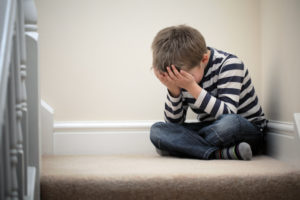What is attachment?
Attachment theory is a psychological theory, developed by John Bowlby (1977), that looks at the connections and relationships between humans. Attachments are those deep emotional bonds that we develop with another person, where we feel secure and close with them. In attachment theory, we examine the relationship between children and their parents, and the way that a parent responds to children’s needs. Bowlby suggested that all children are biologically programmed to form attachments with others, and that these attachments help them to survive. For instance, children use behaviours such as distress, clinging or protest to seek help and connections with parents. When parents respond positively, sensitively and appropriately to a child’s needs they are offered opportunity to develop healthy attachments.
Attachment types
The early experience that children have of their caregivers’ responsiveness to their distress, and the levels of comfort or security that they gain from this, shapes attachment styles into one of four types;
- Secure
- Insecure-anxious/ambivalent
- Insecure-avoidant
- Disorganised-disorientated.
Secure attachment

Secure attachments occur when a child is afforded opportunity to develop a secure caregiver relationship, where they feel comforted and responded to, particularly in periods of stress. In secure attachments, children are offered opportunity to develop autonomy but have the certainty of support from their parent if they need help. They have opportunity to take risks and make mistakes with the knowledge that their parents will guide them and that they will be helped. A parent who develops a secure attachment will:
- Use non-verbal emotional interactions (touch, eye contact)
- Has a warm affectionate tone of voice
- Watches and responds to their baby/child with sensitivity
- Practices being fully present
- Plays with their children
- Are responsive to child’s needs
- Is a safe haven to the child
- Encourages children to explore their surroundings whilst being available to support if needed
Children with a secure attachment are:
- Content
- Can separate from parents
- Seeks comfort from parents if scared or frightened
- Are comfortable with intimacy
- Are self-sufficient
- Have a positive view of themselves & others
- Are resilient
- Can express their emotions
- Feel safe and secure in their relationships
Anxious-Ambivalent attachment
 Those with an insecure-anxious attachment, may be referred to as over-dependent or immature. Anxiously attached children up-regulate their responses to seek their parent’s attention, this may include extreme emotions such as screaming or attention seeking to signal to parents that they need hep. Children with anxious attachments are less confident to explore and experience higher levels of distress when separated from carers. A parent who develops an insecure-anxious attachment may:
Those with an insecure-anxious attachment, may be referred to as over-dependent or immature. Anxiously attached children up-regulate their responses to seek their parent’s attention, this may include extreme emotions such as screaming or attention seeking to signal to parents that they need hep. Children with anxious attachments are less confident to explore and experience higher levels of distress when separated from carers. A parent who develops an insecure-anxious attachment may:
- Use inconsistent parenting
- Responding sometimes, and other times being distracted or not present
- Is not fully present or is distracted
- Could be described as ‘all over the place’
- Overbearing
- Avoiding picking up a baby when crying so as not to ‘spoil’ them
- Parents who are emotionally unavailable
- Overprotective
- Dependent on children to meet their own needs
- Hovering or helicopter parenting style
Children with an anxious attachment may be:
- Emotional
- Anxious
- Clingy
- Have low self-esteem
- Seek constant reassurance
- Are fearful of losing their relationship
- Less independent
- Difficulty regulating and controlling negative emotions
- Learn to up-regulate to get attention e.g. high levels of distress, screaming
- Struggle when parents leave, thinking they are abandoned
Avoidant attachment
 Insecure-avoidant attachments are seen where a child is less reliant on their caregiver, and learns to internalise or down regulate their emotional responses, therefore not seeking help when in distress. The child has learnt, that in distress, their needs will be inconsistently or unpredictably met, such as being rejected or ridiculed. A parent who develops an avoidant attachment may have:
Insecure-avoidant attachments are seen where a child is less reliant on their caregiver, and learns to internalise or down regulate their emotional responses, therefore not seeking help when in distress. The child has learnt, that in distress, their needs will be inconsistently or unpredictably met, such as being rejected or ridiculed. A parent who develops an avoidant attachment may have:
- A failure to meet a child’s needs
- Inconsistent responses to a child
- Have a lack of closeness
- Not responding when a baby or child cries or is in distress
- Actively discourages crying
- No outward emotional reactions to issues or achievements
- Making fun of a child’s problems
- Showing annoyance if a child has a problem
Children with avoidant attachment are:
- Self-reliant
- Avoid or leave conflict
- Have a positive view of self
- Have a negative view of others
- Overly or excessively independent
- Reliant on self-soothing
- Remove themselves to regulate
- Withdraw from others when overwhelmed
Disorganised-Disorientated attachment
 Lastly, disorganised-disorientated attachment styles are frequently associated with children who do not receive good quality care, who may have been neglected or maltreated in childhood. A child with a disorganised attachment experiences disorientated behaviours whereby, they are unable to express their distress or resolve their upset within their caregiver relationship. A parent who develops a disorganised attachment utilises behaviours such as:
Lastly, disorganised-disorientated attachment styles are frequently associated with children who do not receive good quality care, who may have been neglected or maltreated in childhood. A child with a disorganised attachment experiences disorientated behaviours whereby, they are unable to express their distress or resolve their upset within their caregiver relationship. A parent who develops a disorganised attachment utilises behaviours such as:
- Consistent failure to respond appropriately to a child’s distress
- Inconsistent responses to a child’s distress or fear
- Intimidating or using fear to get children to stop crying
- Ignore a child’s cries for long period
- Responding by yelling, criticising, mocking or ridiculing
- Losing patience when a child continues to be distressed
- Laughing at a child’s distress or fear
- Neglectful
- Abusive
Children with a disorganised attachment:
- Want intimacy, but fear it
- A child who is constantly on edge
- Responding to a parent’s presence with tears, avoidance or fear
- Expect to be hurt by others
- Have a fear of rejection
- Have a negative view of themselves & others
- Low self-esteem
- Angry or aggressive
- Have difficulty making friends
- Do not believe that they deserve love
- Feels insecure and unsafe
- May seem dazed or dissociated
Impact of attachment
Our attachments can influence:
- Our relationships in childhood and adulthood
- Our ability to regulate and manage our emotions
- Our stress regulation
- Our adaptability and resilience
- Our self-worth and self-esteem
- Our mental health
- Our behavioural needs
Want to learn more?
If you want to learn more about attachments you can join our Level 4 training (here) or keep an eye out for our new attachment course coming soon (here).
© Dandelion Training and Development – All Rights Reserved
Further help
For more articles about mental health visit – ARTICLES
To learn more about child and adolescent mental health visit – COURSES
For resources to support child and adolescent mental health visit –RESOURCES


